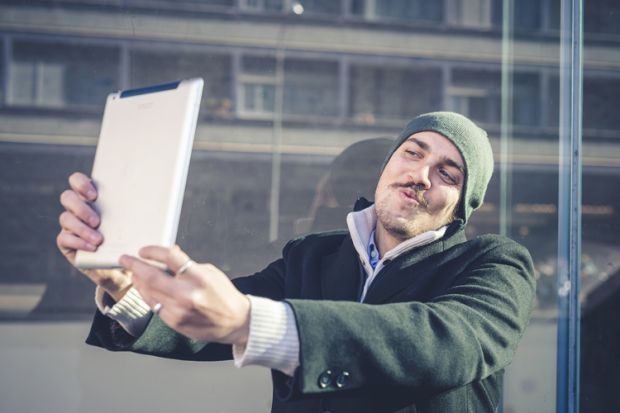When it comes to selfies, most institutions agree: promote - don’t prohibit.
Bryant University may have started a mini-trend when it banned selfies at graduation two weeks ago. Several more universities last week introduced similar bans on phone use as students approach the stage, arguing that stopping to snap means dragging out an already hours-long ceremony - or sullying its significance.
But unless institutions confiscate all camera-equipped devices, chances are many students will spend at least part of their commencement ceremonies with their arms extended, squeezing as many fellow grads as possible into the frame as they immortalise the day. For many universities, not only is that perfectly acceptable behaviour, but it also supports their efforts to engage students with selfies.
Frostburg State University will for a third year in a row include language in its commencement programme on how to celebrate graduation on social media.
“Share your best Commencement photos of your favorite graduates on Instagram, Twitter and Tumblr by tagging them: #instaFrostburg,” the programme reads. “Tweet out your congrats, pics and best wishes using this hashtag: #FrostburgGRAD.”
The language is a “gentle reminder”, said the communications specialist Becca Ramspott, of how today’s alumni-to-be express themselves and communicate with one another.
“It’s sort of patronising to assume that students are going to do that the whole time, or they’re going to do that in a way that robs them of being there in the moment,” she said. “Rather than slap people’s hands, be aware of how to make it a positive thing.”
Besides, a selfie ban cuts both ways. For example, how would instructors at Green Mountain College react if they were no longer allowed to take faculty selfies?
Social media strategists at colleges and universities reacted with incredulity that institutions would devote resources to policing the crowds for phone-toting students at graduation - a day when “there’s just so much to do in general”, said Michael O’Neill at Ithaca College.
“That seems about as improbable as saying you can’t decorate the top of your cap,” Mr O’Neill, Ithaca’s social media strategist, said. “I’m completely shocked that that’s a thing.”
Ithaca has embraced the selfie through the self-referential Real Life Ithaca College project. For events such as the last day of class and induction for freshers, the college rolls out physical picture frames that resemble the Instagram feed.
“We’ll put real-world stuff into social media, so I thought it would be interesting to bring social media into the real world,” Mr O’Neill said.
Since the frames also feature a comment from college’s official Instagram account with the hashtags “#IthacaCollege” and “#RLICInstagram”, students are given a visual clue about how to tag their own shots. That, in turn, makes it easier for Mr O’Neill to curate the best submissions to support the college’s marketing efforts.
The University of Texas at Austin also steered students’ selfie use last year to build excitement about its entering class. The university included a banner with the hashtag “#gonetotexas” with its first round of acceptance letters, and encouraged students to announce they would join “#UT18” - the class of 2018. The result: pages upon pages of Facebook posts, tweets and Instagram photos of excited high school seniors - which the university compiled in the online publication Know.
To avoid having too heavy a hand, many universities recruit students to inform their social media use. While their top priority is to keep track of emerging trends and platform, the students are sometimes able to turn campus traditions into PR strategies.
Isaac Risseeuw, a self-described “super-super senior” at the University of Wisconsin at Eau Claire, was able to take advantage of the campus’s reputation as one of the coldest in the country.
Last December, when temperatures dropped to -40 degrees, the campus bookstore invited students to show their #BridgeFace after crossing the infamous footbridge that spans the Chippewa River. More than 130 students entered for a chance to win a gift card.
“Everyone complains that they don’t want people to see what they look like after they walk across the bridge,” Mr Risseeuw, then a social media volunteer for the student centre, said. “You look terrible, so we decided to turn that on its head.”
Now a PR and marketing intern at the university, Mr Risseeuw plans a similar selfie campaign for students who make the “epic climb” up the hill to where most of the residence halls are located. Later this year, students can celebrate their achievement in front of a mock press conference backdrop, he said.
Mr Risseeuw encouraged more universities to hand over control of their social media accounts to students, describing his work with social media on campus as a “really great hands-on experience to show my love for the university.” Although he admitted he’s “not a huge fan of the selfie”, he recognised its potential as a creative outlet.
“It’s a really personal way to show what’s happening in the moment,” he said.




